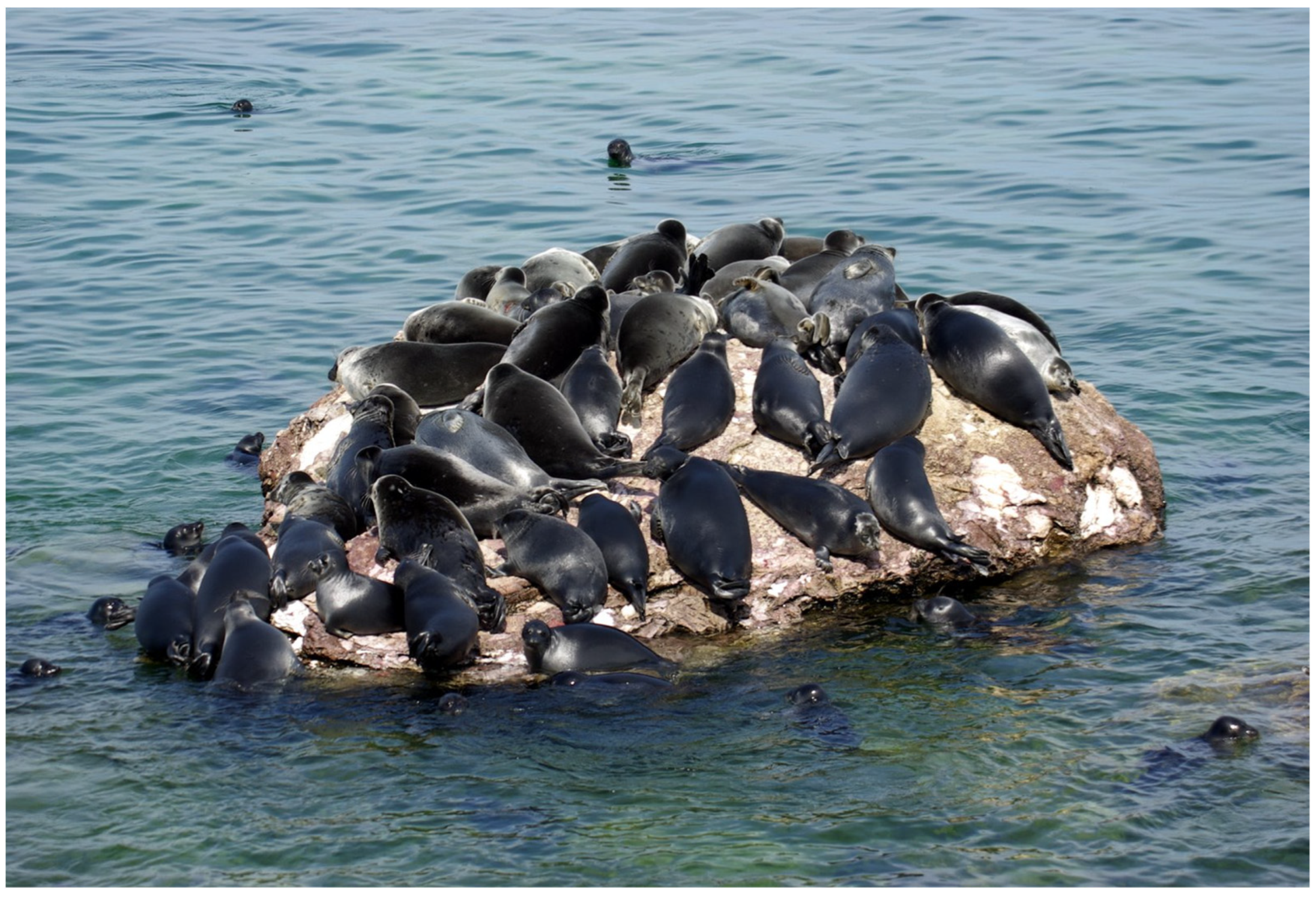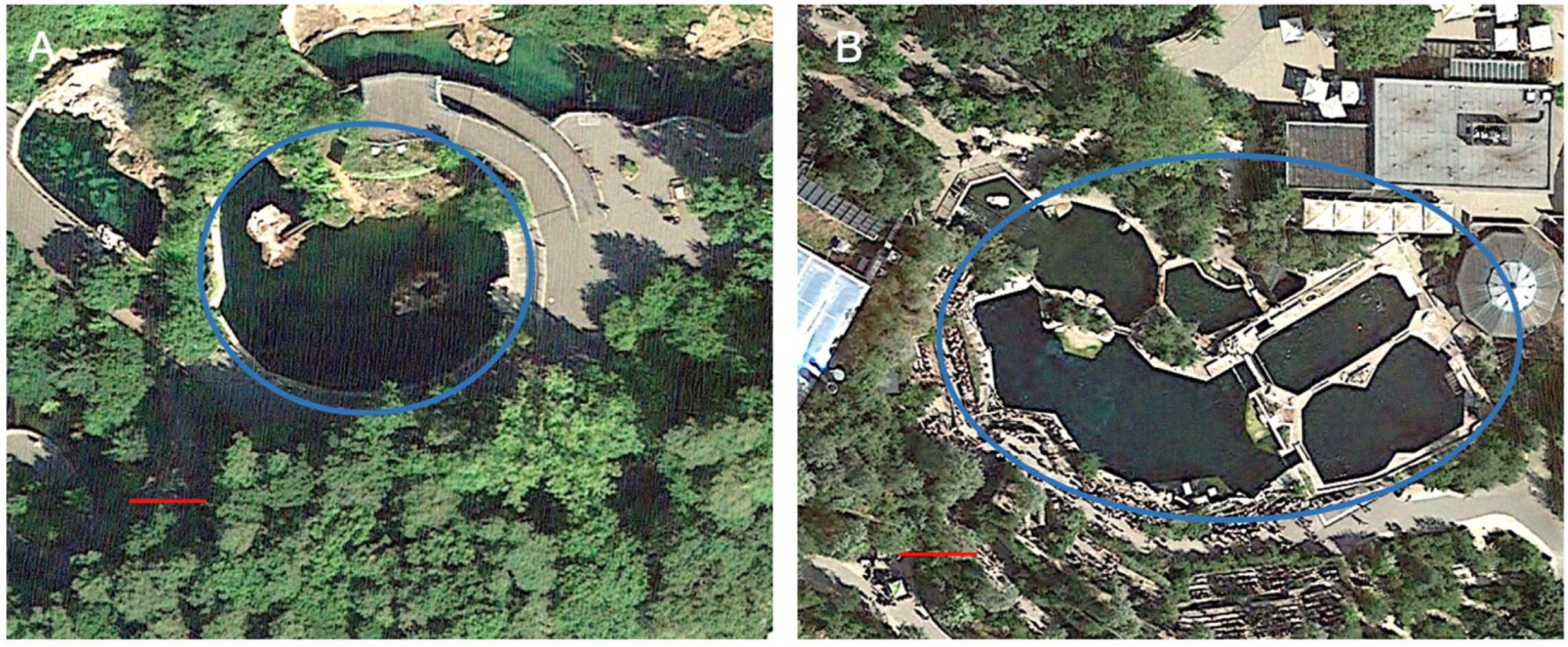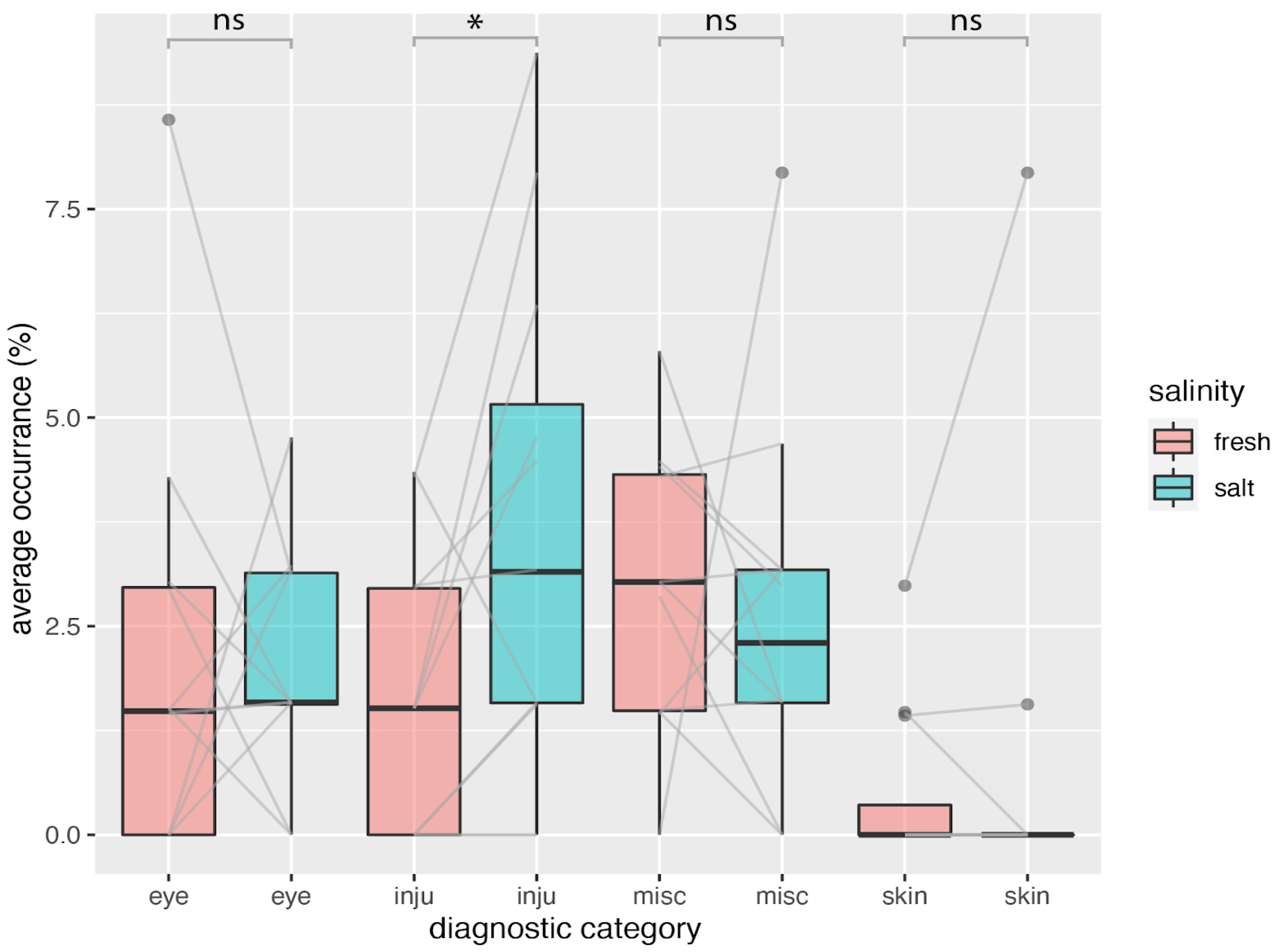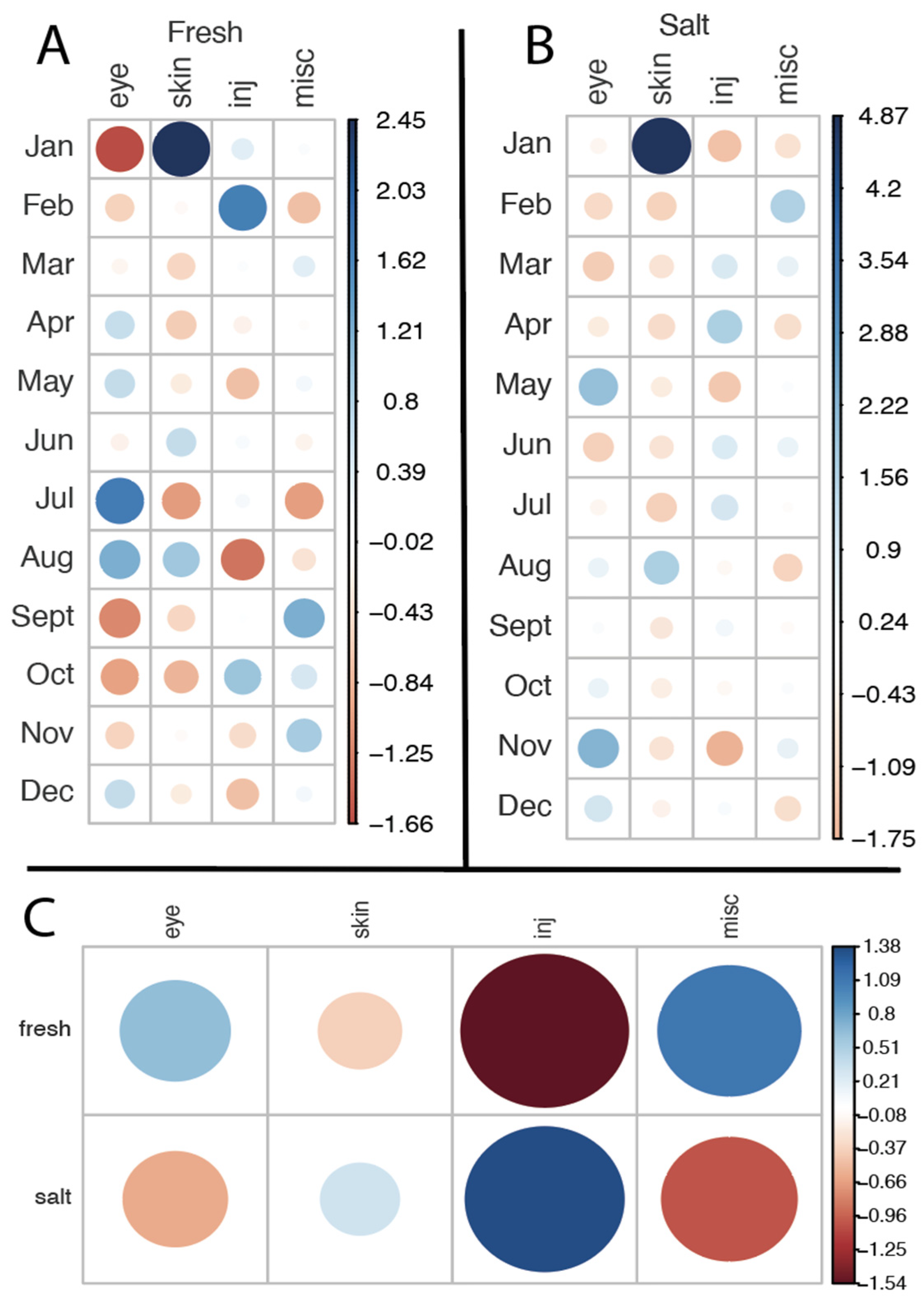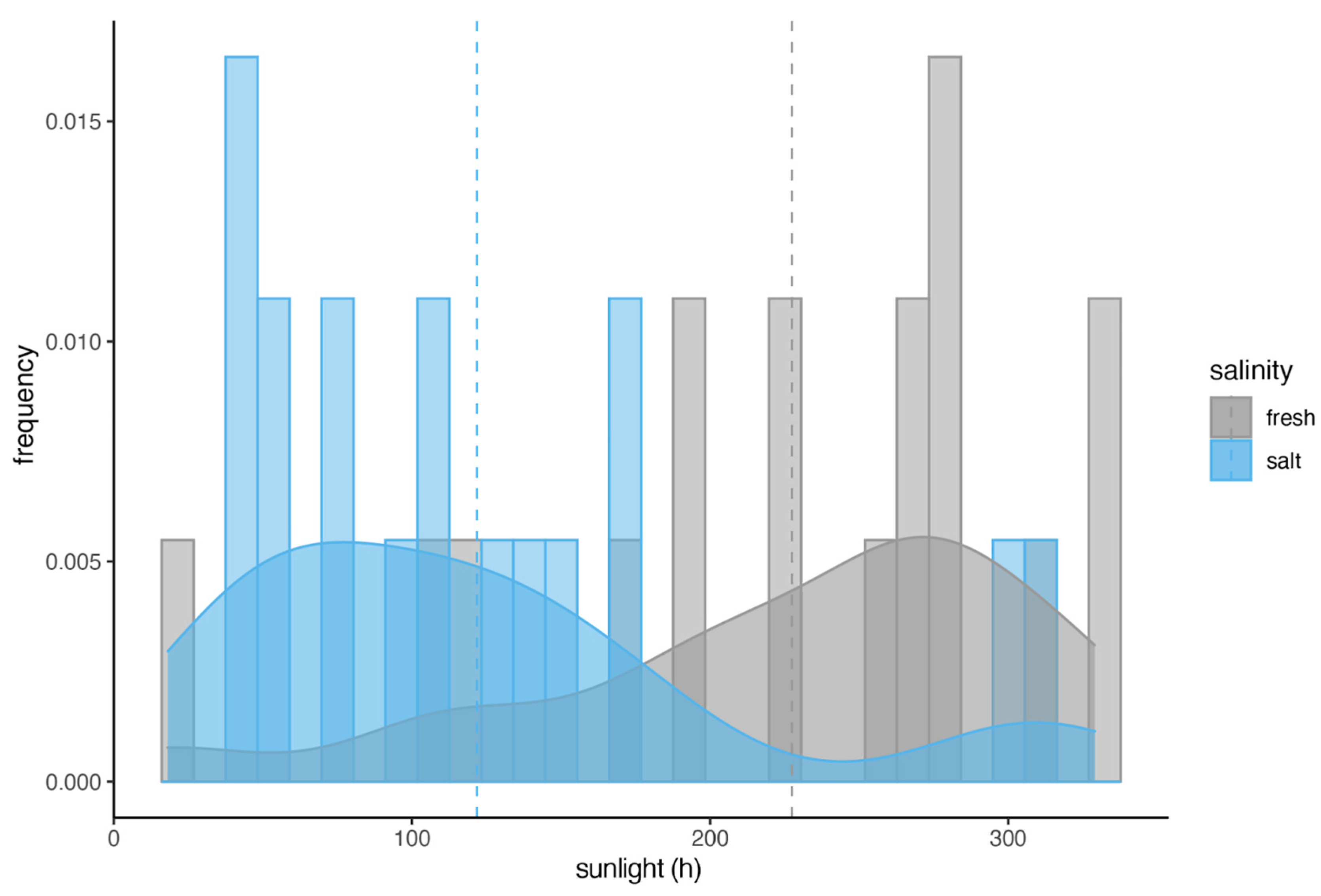1. Introduction
Pinnipeds are popular animals in zoos and aquariums around the world. Currently, 326 California sea lions (
Zalophus californianus) are living at 64 institutions accredited by the EAZA (European Association of Zoos and Aquaria). Ensuring individual health is one of the most important factors in guaranteeing optimal welfare for animals in managed collections. Eye problems are common in these populations [
1,
2,
3,
4,
5,
6,
7,
8] and often necessitate complex medical treatments and surgical interventions, which can be challenging.
Eye disorders in pinnipeds are multifactorial, as suggested by Colitz et al. [
1,
2,
3] and other authors [
5,
6]. Key parameters to consider include water salinity, disinfection methods, pH levels, and diet, as well as environmental factors such as seasonal changes, temperature, sunlight exposure and resulting UV radiation, and reflectivity of the pool wall.
In zoos, brightly painted pool walls are a significant factor in increased sunlight exposure, as they absorb UV radiation less effectively than darker surfaces [
4,
9]. In addition, pinnipeds under human care frequently need to look upwards during training, feeding, and presentations, which can elevate their exposure to UV radiation. Heightened social interactions within the group can lead to more frequent eyelid opening, further enhancing their sunlight exposure [
9]. Collectively, these factors increase the duration that these animals spend with their eyes open, thereby boosting their sunlight exposure levels. Ocular lesions in otariids were more common in months with higher sunlight exposure and longer daylight hours [
3,
4]. In addition, facilities located closer to the equator report higher incidences of eye disease [
3]. Even in sunny winter months snow can increase sunlight exposure, which may exacerbate the effect. Considering these findings, the German Federal Ministry of Food and Agriculture (BMEL) recommends using darker pool colors and providing shaded feeding areas to minimize sunlight exposure [
10].
Some authors argue that housing sea lions in freshwater may lead to an increased risk of eye diseases [
1,
8], as these animals are naturally adapted to marine environments. Dunn et al. [
8] found that cataracts in harbor seals were three times more common in freshwater than in saltwater. Stach and Eule [
11] describe a correlation between freshwater housing and the development of corneal oedema in
Zalophus. In their study of 209 pinnipeds in 25 facilities in Germany, Austria, and Switzerland, they reported that eye disease was significantly more common in animals housed exclusively in freshwater than in those with access to saltwater pools. This is in agreement with the results of Colitz et al. [
1,
3], who show that the occurrence of keratopathy was higher in facilities with salinity levels below 29 g/L (64%) compared to salinity levels of over 29 g/L (52.7%). The authors concluded that a higher salinity provides some protection against this disorder, and stated that keratopathy is more difficult to manage in animals housed in freshwater. The BMEL recommends that pinnipeds should be housed in seawater or water with similar salinity [
10].
However, it is important to consider that pinnipeds in the wild thrive in aquatic environments with varying salinity levels. While most pinniped species are primarily marine, several have exhibited remarkable resilience in freshwater habitats, either seasonally or even constantly. Notable examples include the Baikal seal (
Pusa sibirica) (
Figure 1), which is uniquely adapted to live exclusively in Lake Baikal, Siberia, making it one of the few true freshwater seal species [
12]. Furthermore, the ringed seal (
P. hispida) has two notable subspecies that inhabit freshwater systems: the Ladoga seal (
P. h. ladogensis), found in Lake Ladoga in Russia, and the Saimaa ringed seal (
P. h. saimensis), which resides in Lake Saimaa in Finland. Additionally, the harbor seal (
Phoca vitulina) has been observed in estuarine and riverine systems along the coasts of North America and Europe, often entering freshwater rivers to hunt for fish or haul-out on riverbanks [
13]. A population of harbor seals is resident to Iliamna Lake in Alaska [
14], and a subspecies of the harbor seal in Canada, the Ungava seal (
P. v. mellonae), lives exclusively in freshwater [
15]. The California sea lion (
Zalophus californianus) and Steller sea lion (
Eumetopias jubatus) have also been documented in freshwater environments, albeit temporarily, as they migrate between breeding sites and feeding areas, exploiting available resources [
16]. Considering this adaptability of many pinniped species to various aquatic environments, it can also be assumed that for California sea lions under human care, freshwater might not cause problems. The occurrence of eye problems in zoos and aquariums should therefore not only be attributed to water salinity, especially considering that pinnipeds have evolved to live in a variety of aquatic ecosystems. Understanding the multifaceted factors contributing to ocular health in these animals is crucial for improving their welfare in managed settings.
The aim of the present study is to investigate the relationship between the housing conditions of two groups of California sea lions—those housed in a freshwater facility and those in a saltwater facility at Nuremberg Zoo—and the occurrence of associated ocular diseases over a ten-year period. A primary advantage of comparing animals that reside in the same zoo is that they are exposed to similar environmental factors, such as sunlight exposure and temperature, as well as the same feeding regime and supplementation. The core objective of this study is to determine the extent to which water habitat may influence the incidence of ocular problems and other disease types in these animals, and to compare our findings with the existing literature on the occurrence of eye diseases associated with different aquatic habitats.
4. Discussion
In this study, we investigated the incidence of ocular diseases in California sea lions (
Zalophus californianus) at Nuremberg Zoo, specifically examining the impact of water habitat, comparing freshwater versus saltwater. Over our 10-year survey period from 1 January 2012 to 31 December 2021, we recorded 32 cases of eye diseases. These accounted for 25% of a total of 129 cases of medical records for 19 individuals examined. Our results indicate that salinity does not have a significant effect on the incidence of ocular diseases in California sea lions (
Figure 4C). While we noted a trend suggesting an increase in eye problems during the summer months in the freshwater habitat, this trend was not statistically significant (
Figure 4A). The freshwater enclosure is less deep, with only one third of the water volume compared to the saltwater facility; therefore, the increase is likely to be related to deteriorating water quality due to higher temperatures and longer daylight hours in summer. The saltwater facility features a superior filtration and life support system, which ensures more stable water quality throughout the year. However, the total amount of ocular diseases did not significantly differ between the salt- and freshwater facilities (
Figure 3 and
Figure 4).
A prevalent opinion is that the absence of seawater in certain managed populations contributes to the development of eye diseases [
1,
4,
8]. These findings have been challenged by research that investigated other pinniped species, such as grey seals (
Halichoerus grypus), which can thrive in freshwater environments [
18], as well as other species that sometimes permanently inhabit freshwater [
12,
13,
14,
15]. A study in North Rona, Scotland, using ecological niche factor analysis, found that lactating female grey seals showed a clear preference for lower salinity pools. This behavior was most pronounced early in the season when thermal stress is highest, suggesting that grey seals may use freshwater pools not only for cooling but also for drinking. California sea lions have also been recorded in freshwater environments, albeit temporarily, as they migrate between breeding sites and feeding areas, exploiting available resources [
16]. This evidence challenges the assumption that seawater is essential for the well-being of managed pinnipeds, suggests that freshwater may be a viable environment for some pinniped species, and questions whether salinity alone is responsible for the observed eye conditions [
19].
In support of this, Gage [
9] raised doubts about the effect of freshwater housing on eye disease, citing personal observations of sea lions in a northern freshwater facility with a black pool and a constant flow from an underground aquifer. None of the animals showed corneal lesions, in contrast to sea lions housed in a southern facility with natural saltwater but light blue, highly reflective pools, where many developed corneal damages. Gage [
9] argued that certain freshwater environments do not cause eye disease and that other factors, such as pool color and light reflection, may be more important.
A second factor mentioned in relation to eye problems in pinnipeds under human care is their exposure to oxidizing agents. Halogens (primarily chlorine) or ozone are commonly used to treat pool water. The concentration of these agents in water systems can have a significant impact on the eye health of California sea lions. Halogens can react with organic matter (particularly nitrogen compounds) to form halogenated hydrocarbons or halogen amides, which are known to be irritating to the eyes. Halogen amides, such as mono- or dichloramines, can cause discomfort, while chlorinated hydrocarbons can cause liver damage [
19]. In addition, chlorinated hydrocarbons can interfere with the cytochrome P450 enzyme system in the ciliary body of the eye, potentially causing damage there as well [
20]. Colitz et al. [
3] suggested that “chemicals used to disinfect enclosures and disinfection by-products may affect the preocular tear film and corneal epithelium, predisposing corneas to ulceration and secondary infection”. De Haan [
21] showed a correlation between the concentration of total, free, and bound chlorine in swimming pool water and the severity of corneal lesions in California sea lions, with bound chlorine showing the most significant effect. The EAZA and EAAM (European Association for Aquatic Mammals) guidelines for the care of eared and fur seals recommend careful monitoring of water quality when using chlorine for disinfection and advise that the total chlorine concentration should not exceed 1.0 ppm [
19]. When using ozone for water treatment, it is important to ensure that ozone is removed from the water as much as possible after its reaction in sealed chambers. The optimum ozone reduction potential (ORP) for treated water should exceed 700 mV, while water in contact with animals should maintain an ORP of less than 400 mV to prevent eye damage [
19]. Higher ORPs in pool water can lead to conditions such as blepharospasm or epiphora [
9]. In addition, Colitz [
3] showed that the combination of ozone and chlorine can significantly promote the development of eye disease. Interestingly, a lower prevalence of eye diseases was reported in pinnipeds housed in water without chemical additives [
5,
6]. Water disinfection in the Lagoon is carried out using ozone, and to a very limited extent by adding chlorine, while at the Aquapark facility only UV light is used for disinfection. This could be a reason why we found eye disorders more evenly distributed throughout the year at the Lagoon (
Figure 4 and
Figure 5). Further research is needed in this area.
To assess the causes of eye problems in pinnipeds, it is essential to define the environmental challenges faced by these animals under human care compared to their wild counterparts [
1,
9]. As already mentioned, there is evidence that UV radiation plays a significant role. Pinniped eyes are adapted to low-light environments, particularly for foraging at depth or in murky waters with minimal light penetration. In zoos, however, pinnipeds are often fed at the surface, exposing their eyes to much higher levels of UV radiation than they would typically experience in the wild. The analysis of sunlight exposure and its correlation with the frequency of ocular diseases revealed distinct patterns between the freshwater and saltwater facilities (
Figure 5). As all California sea lions were housed at Nuremberg Zoo, they experienced the same climate, were subjected to the same amount of sunlight, and also received the same diet. Therefore, one might expect a similar trend in the frequency of ocular diseases in both freshwater and saltwater facilities if sunlight exposure had a significant influence. However, it is important to note that the freshwater facility is considerably smaller, less deep, and with fewer opportunities to rest on land, which may result in fewer shaded areas for the animals. We did not assess the specific amount of shade or the locations where the California sea lions rested or were fed throughout the day, which could provide insights into their exposure to sunlight. This lack of data may limit our understanding of the full impact of sunlight exposure on the ocular health of these animals. Future studies should consider evaluating the shading patterns and resting behaviors of California sea lions to better understand the relationship between sunlight exposure and ocular disease prevalence.
Further factors influencing eye problems in pinnipeds under human care are age and sex. Like in humans and dogs, age has a significant effect on the development of eye disease in California sea lions. Colitz et al. [
3,
4] confirmed that animals over 20 years of age had significantly higher rates of keratopathy, and described nuclear sclerosis in animals aged 15 to 20 years and cataracts in all individuals over 26 years of age. They attributed these changes to a decline in antioxidant capacity with age [
3]. Nakamura et al. [
5] also found a correlation between age and lens disorders, noting that older animals had a higher incidence of such problems, while younger animals had more corneal lesions, probably due to increased activity leading to eye injuries. California sea lions in our study were aged between at least 2 years and 29 years 5 months. As we wanted to focus on adult animals, we excluded animals younger than 2 years from our study. Juveniles were regularly moved to other facilities (see
Section 3.1), which made it not possible to obtain long term data. Eye disorders in the group housed in the freshwater facility occurred at an average age of 13.4 ± 8.8 years; for those housed in the saltwater facility, the average age of occurrence was 12.6 ± 6.7 years. A histogram showing the age distribution of the animals for each diagnosis is available in the
Supplementary Materials (Figure S4).
The role of sex in predisposing to eye disease has also been discussed. Stach and Eule [
11] found that male pinnipeds suffer from eye diseases more often than females, a finding supported by Miller et al. [
7]. However, Nakamura et al. [
5] found no correlation between the incidence of eye disease and sex. Aggressive behavior, particularly in males, may contribute to more eye injuries, as noted by Colitz et al. [
3] and Nakamura et al. [
5]. This topic could not be addressed by our study because of the limited number of males. Notable differences were observed in the distribution of eye diseases between wild individuals and those under human care. Miller et al. [
7] examined enucleated eyes from 70 pinnipeds, predominantly
Zalophus californianus, but also from other species. Among the animals living in the wild, 35% (13 out of 37 individuals) exhibited an eye disease, while the prevalence was significantly higher, at 81.5% (22 out of 27 animals) in pinnipeds under human care. Keratitis and pathological changes to the Descemet membrane were only documented in animals under human care. The study did not categorize individuals according to specific husbandry conditions [
7].
Eye disorders in pinnipeds are multifactorial, as suggested by Colitz et al. [
1,
3] and other authors [
5,
9]. Therefore, we believe it would be a significant and unjustified limitation for guidelines to focus exclusively on the freshwater versus saltwater debate. Although the current study is preliminary and not yet conclusive, it suggests that ocular diseases occur with similar frequencies in both saltwater and freshwater facilities. We strongly encourage further research on eye conditions in pinnipeds and their causes. A comprehensive comparison of ocular conditions in pinnipeds residing in saltwater versus freshwater environments should consider a broad array of variables beyond just salinity. Regular monitoring of all factors over a 12-month period is essential to establish correlations between environmental factors and eye health. This should be combined with detailed ocular monitoring by veterinarians, including photographic documentation, to track the condition of the eyes over time rather than just assessing them when a disease is diagnosed, as it was made for this study.
We propose a systematic approach to photographing the eyes of California sea lions on a monthly basis. This process will involve the implementation of a fixed head position, alongside a defined camera angle and distance, to ensure consistency in each image captured. To mitigate issues such as light reflections on the eye, we emphasize the importance of controlling lighting conditions. Conducting the photography sessions in indoor enclosures will allow for the use of indirect lighting, which helps to diffuse harsh light and reduces glare. By carefully selecting the type of lighting and positioning it in a way that uniformly illuminates the head of the California sea lion, it will be possible to standardize the procedure. This will enhance image clarity by minimizing unwanted reflections and shadows, leading to more reliable diagnostic results. In addition to the fixed head positioning and controlled lighting, we recommend developing a standardized protocol to accommodate the animals prior to imaging. This includes familiarizing them with the setup as part of medical training sessions, which will ensure the animals are comfortable during the process, making regular imaging sessions more efficient and effective. By adhering to these methods, we aim to create a robust standard operating procedure that minimizes variability in image capture, thus facilitating accurate assessment and diagnosis of any ocular conditions present in the California sea lions, while contributing to the overall welfare of the animals involved in the study.
